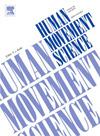帕金森病患者的肢间步态不对称
IF 1.9
3区 心理学
Q4 NEUROSCIENCES
引用次数: 0
摘要
步态不对称是帕金森病(PD)的一个标志,导致不稳定、跌倒风险增加和生活质量下降。虽然时空不对称已被广泛研究,但在整个步态周期中,特别是在开药和停药状态下,对关节运动学不对称的研究有限。本研究评估了PD患者与神经健康老年人在行走过程中下肢角运动的肢体间不对称性。23名PD患者和18名健康老年人参与了研究。PD参与者在开药和停药状态下进行评估。运动捕捉系统记录了10米步行过程中髋关节、膝关节、踝关节和骨盆的角度运动学。分析了关节角位移的时空步态参数,包括步长和步幅。统计参数映射(SPM)评估了多侧和少侧受影响的时间不对称性。健康老年人在关节运动方面没有明显的不对称性。PD患者在开状态和关状态下均表现出髋关节(分别占步态周期的34%和47%)、膝关节(分别占步态周期的30%和23%)和踝关节(仅在关状态下占步态周期的29%)运动的运动学不对称。药物治疗对减少运动不对称的效果有限。PD患者在开启和关闭状态下的不同步态周期阶段,髋关节、膝关节和踝关节表现出角度不对称。检测下肢角度运动学的显著不对称性表明治疗方法应针对特定的肢体间差异进行定制。本文章由计算机程序翻译,如有差异,请以英文原文为准。
Inter-limb gait asymmetry in people with Parkinson's disease
Gait asymmetry is a hallmark of Parkinson's disease (PD), contributing to instability, increased fall risk, and reduced quality of life. While spatiotemporal asymmetry has been widely studied, limited research has examined joint kinematic asymmetries throughout the gait cycle, particularly in both ON- and OFF-medication states. This study evaluated inter-limb asymmetry in lower limb angular kinematics during walking in individuals with PD compared to neurologically healthy older adults. Twenty-three individuals with PD and 18 healthy older adults participated. PD participants were evaluated in ON- and OFF-medication states. A motion capture system recorded angular kinematics of the hip, knee, ankle, and pelvis during a 10-m walk. Spatiotemporal gait parameters, including step length and stride time, were analyzed alongside joint angular displacement. Statistical Parametric Mapping (SPM) assessed temporal asymmetries between the more and less affected sides. Healthy older adults exhibited no significant asymmetry in joint kinematics. People with PD showed kinematic asymmetries, in both ON and OFF-states, for hip (34 % and 47 % of gait cycle, respectively), knee (30 % and 23 % of gait cycle, respectively), and ankle (29 % of gait cycle – only in OFF-state) movements. Medication had limited effects on reducing kinematic asymmetries. People with PD showed angular asymmetries in the hip, knee, and ankle during different gait cycle phases in ON and OFF states. Detecting significant asymmetry in lower limb angular kinematics suggests that therapeutic approaches should be tailored to address specific inter-limb differences.
求助全文
通过发布文献求助,成功后即可免费获取论文全文。
去求助
来源期刊

Human Movement Science
医学-神经科学
CiteScore
3.80
自引率
4.80%
发文量
89
审稿时长
42 days
期刊介绍:
Human Movement Science provides a medium for publishing disciplinary and multidisciplinary studies on human movement. It brings together psychological, biomechanical and neurophysiological research on the control, organization and learning of human movement, including the perceptual support of movement. The overarching goal of the journal is to publish articles that help advance theoretical understanding of the control and organization of human movement, as well as changes therein as a function of development, learning and rehabilitation. The nature of the research reported may vary from fundamental theoretical or empirical studies to more applied studies in the fields of, for example, sport, dance and rehabilitation with the proviso that all studies have a distinct theoretical bearing. Also, reviews and meta-studies advancing the understanding of human movement are welcome.
These aims and scope imply that purely descriptive studies are not acceptable, while methodological articles are only acceptable if the methodology in question opens up new vistas in understanding the control and organization of human movement. The same holds for articles on exercise physiology, which in general are not supported, unless they speak to the control and organization of human movement. In general, it is required that the theoretical message of articles published in Human Movement Science is, to a certain extent, innovative and not dismissible as just "more of the same."
 求助内容:
求助内容: 应助结果提醒方式:
应助结果提醒方式:


